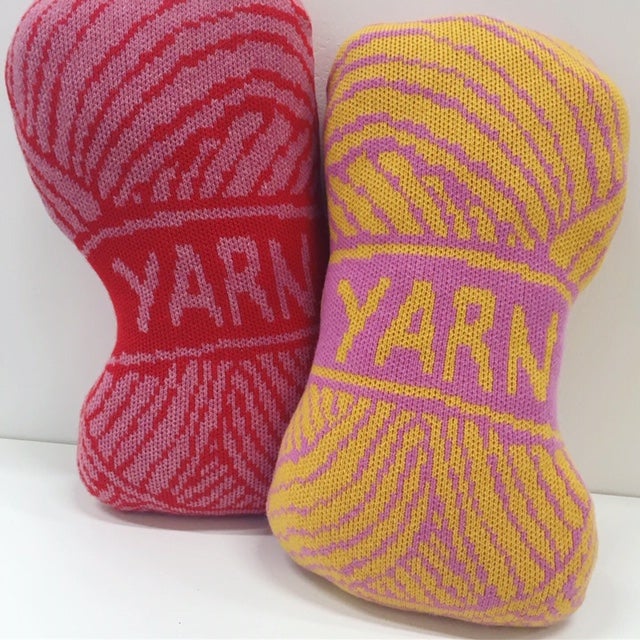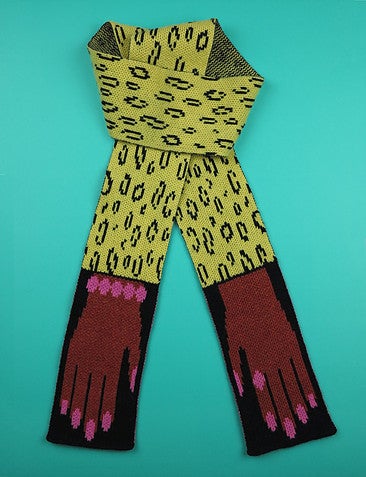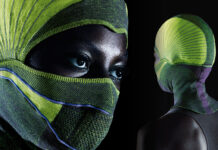Knitwear designer, maker and lecturer Kandy Diamond’s brand ‘Knit and Destroy’ was launched in 2006. Her knitted products aim to “challenge cultural preconceptions by offering alternative representation of knitting”. We caught up with Kandy to learn more about her brand and creative processes.

After graduating from UMIST, now The University of Manchester, with a BSc in Textile Design and Design management with Industrial Experience, Kandy gained experience within design offices. “A design office environment wasn’t for me; that experience definitely spurred me on to do my own thing. We also learned about business as part of the degree, setting up a small business as part of our final year module. I think this really helped me to start my own brand on leaving university.” Kandy set up ‘Knit and Destroy’ in a bid to make crafted, designer made pieces accessible and affordable, whilst focussing on her own creative pursuits.
Machine knitting has always been Kandy’s specialist area, combining this with machine sewing and crochet where it makes sense for the design. Sharing some of the visual inspiration that influences her aesthetic, Kandy explained, “I feel like hand knit and craft in general influence my style. I love novelty knits and a bold, graphic aesthetic. Lots of other art and design also influences what I make too. I like looking at anything from photography to installation art and food packaging for inspiration.”

Kandy’s ‘Tape-measure Scarf’ was one of her first designs, with ideas originating from creating large scale versions of everyday things. This is one of Kandy’s best-selling designs. Other early designs such as her ‘crayon and pencil scarf’ and musical, piano themed designs also kick started her small business in the early days. Realising though that she must diversify to generate year-round trans-seasonal business, she began to expand her product offerings, “The first spring saw cushions, glasses cases and lots of accessories. From the early days I’ve continued to follow my instincts in terms of what I want to make. I often work on themed collections as it helps me focus and make sense of what I’m doing.”

As ‘Knit and Destroy’ evolved, Kandy began to explore other ideas too. Pieces which were not necessarily worn accessories or objects for the home became pieces to be displayed as art. Joining an art collective with two friends spurred on these ideas within a group installation which allowed limitless creativity and playfulness with scale and size.
‘Knit and destroy’ soon became a brand with a strong aesthetic channelled into products as well as aesthetic led pieces for exhibition contexts. Kandy continues to explore both avenues as her brand evolves.

The majority of Kandy’s knits are manufactured by herself on her PassapE6000 domestic knitting machine. Most of her knits are two colours, but some are three in places with birds-eye-back structures. Explaining why she has always stuck with this machine, Kandy shared, “I like this machine for two main reasons. The first is that you can download designs as big as you like which makes it great for graphic art works. The second is that I can create double layer fabrics with no floats on the back which makes the machine perfect for knitting scarves. The machine produces a great quality of fabric that works well for what I do.”
When generating the visuals for her designs, Kandy works by scaling up the object first, and then translates this within the digital knit software Design-a-knit. to draw out the fabric design before downloading the pattern, knitting the fabric and constructing the finished piece.
Rather than doing lots of designing on paper, Kandy does most of her stitch development digitally, “If it’s something more abstract like my ‘Alien Babe Hug Scarf’, I sketch out the design roughly then work on it in Design-a-Knit digitally.”

Explaining the inspiration behind the ‘Alien Babe’ scarf design, Kandy detailed, “It came from a collaboration I did a few years back with a Swedish designer who wanted to make hug scarves. We worked together on the initial hug designs and I then digitally developed them into knittable designs. The alien babe was a take on the ‘witchy’ hug that we had designed together. I love the idea of a glamorous alien and I had the perfect shade of mint green to work with. Of course I gave the nails a bit of lurex because what self-respecting alien wouldn’t wear glitter nail polish?!”
Though her knitting machine preference hasn’t changed since 2006, Kandy’s material choices have. Acrylic was the most accessible yarn for her back then, offering great colour choices at her local market. As her business evolved with more time to review and assess material choices, Kandy made the decision to switch production to 2/17s lambswool. This initiated a price restructure and business remodel, as Kandy sought to justify her increased costs to often sceptical craft fair visitors.
Craft and artisan making vs hobby crafts are so often aligned in the eyes of consumers leading them to presume products are over-priced, claiming they could ‘make them at home themselves’. Contending with this unfortunate view is part of the challenge for Kandy, who designs, programmes and makes her knits entirely herself- the standard and complexity of which certainly couldn’t be made by just anyone.

An important part of Kandy’s creative practice is also the sharing of her knowledge through workshops. In 2015, Kandy evolved the business by moving into a studio space and out of the spare room at her home. This gave her the space to focus on her making practice – and crucially- the space to run knitting workshops with the general public. As an experienced lecturer in knitted textiles and knitwear design, Kandy naturally finds running workshops within her practice works very well. Though her workshops moved online during the pandemic, Kandy hopes to bring these back to her studio in the Autumn.
The professional balance that Kandy has achieved contributes to her creative practice too. Kandy is currently a senior lecturer at Nottingham Trent University. Splitting her time between her creative practice and her job as a lecturer, she shares her skills, knowledge and creativity with students whilst nurturing her creativity too, “It’s nice to have both. Working with students can be inspiring. I think they value the practice led approach that I bring to my teaching because I’m able to empathise with their processes. I am always in the midst of my own creative processes, so if a student needs to problem solve a technique or needs motivation to get through a difficult challenge, I utilise my experience within my own practice to motivate them.”

As previously mentioned, Kandy currently produces all her knits by herself. Manufacturing for small knit brands within the UK is certainly a challenge. Factories can be reluctant to take on small minimums for production, and spinners often have high minimums too. Kandy is currently navigating this challenge as she hopes to outsource some of her production to expand her brand further.
Sharing her ideas for the future of ‘Knit and Destroy’, Kandy said, “Recently I have been looking at options for having a few of my products manufactured in the UK rather than making them myself. There are a few reasons for this, but it is mostly to free up my time to work on new designs. My most popular continuity pieces don’t require design time anymore, but they take a lot of time to manufacture myself. Production days then take over and don’t allow time for new product developments. Small batch UK production with power knitting machines is difficult to find. I am excited now though to have found Knit Shop Scotland founded by knit designer Donna Wilson , which takes business from clients with small production minimums. This is a really good opportunity for brands like mine- it would be great to work with them.”

Working on some exciting projects to be revealed soon, Kandy discussed what might be next for ‘Knit and Destroy’, “I don’t really do plans, but I hope to be able to continue knitting whatever I fancy, and helping other people discover the joys of machine knitting. I spent a large part of the last year working on a big project that I’ve been told I cannot announce yet, but let’s just say this project will help other people discover machine knitting… I spent too much time on my big secret project and I’ve not made any new designs for products or art for a while so I’m itching to do that.”
With the potential for upscaling on the horizon and a growing consumer interest in products ‘made in the UK’, Kandy is poised to push ‘Knit and Destroy’ into new territory. As workshops return to her studio, keep an eye on Kandy’s Instagram and website to learn more.


Subscribe To Our Newsletter
Join our mailing list to receive the latest news and updates from our team.






